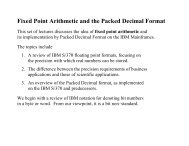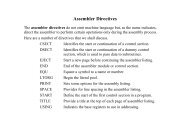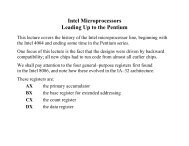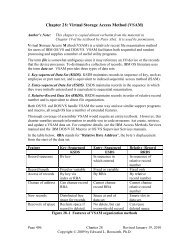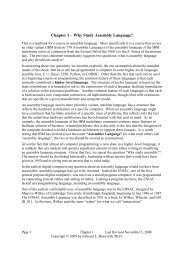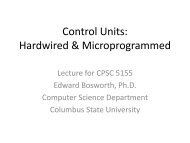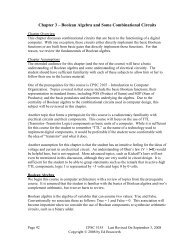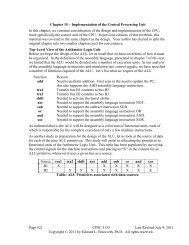Microprogramming: History and Evolution - Edwardbosworth.com
Microprogramming: History and Evolution - Edwardbosworth.com
Microprogramming: History and Evolution - Edwardbosworth.com
You also want an ePaper? Increase the reach of your titles
YUMPU automatically turns print PDFs into web optimized ePapers that Google loves.
<strong>Microprogramming</strong> is Taken Seriously<br />
It was with the introduction of the IBM System/360 that microprogramming was taken<br />
seriously as an option for designing control units. There were three reasons.<br />
1. The recent availability of memory units with sufficient reliability <strong>and</strong><br />
reasonable cost.<br />
2. The fact that IBM took the technology seriously.<br />
3. The fact that IBM aggressively pushed the memory technology inside the<br />
<strong>com</strong>pany to make microprogramming feasible.<br />
IBM’ goals are stated in the 1967 paper by Tucker.<br />
―<strong>Microprogramming</strong> in the System/360 line is not meant to provide the problem<br />
programmer with an instruction set that he can custom–tailor. Quite the<br />
contrary, it has been used to help design a fixed instruction set capable of<br />
reaching across a <strong>com</strong>patible line of machines in a wide range of performances.<br />
… The use of microprogramming has, however, made it feasible for the smaller<br />
models of System/360 to provide the same <strong>com</strong>prehensive instruction set as the<br />
large models.‖<br />
Tucker notes that the use of a ROS [Read Only Store] is somewhat expensive, be<strong>com</strong>ing<br />
attractive only as ―an instruction set be<strong>com</strong>es more <strong>com</strong>prehensive‖.<br />
Source: (Page 225 of Tucker, 1967)



